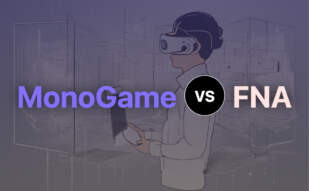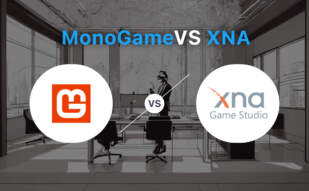MonoGame is a free, open-source C# framework initially released in September 2009 by the MonoGame Team. Known for its capability in creating games for multiple platforms like iOS, Android, and more. It reimplements the Microsoft XNA 4 API and has been used for known games such as Bastion and Celeste.
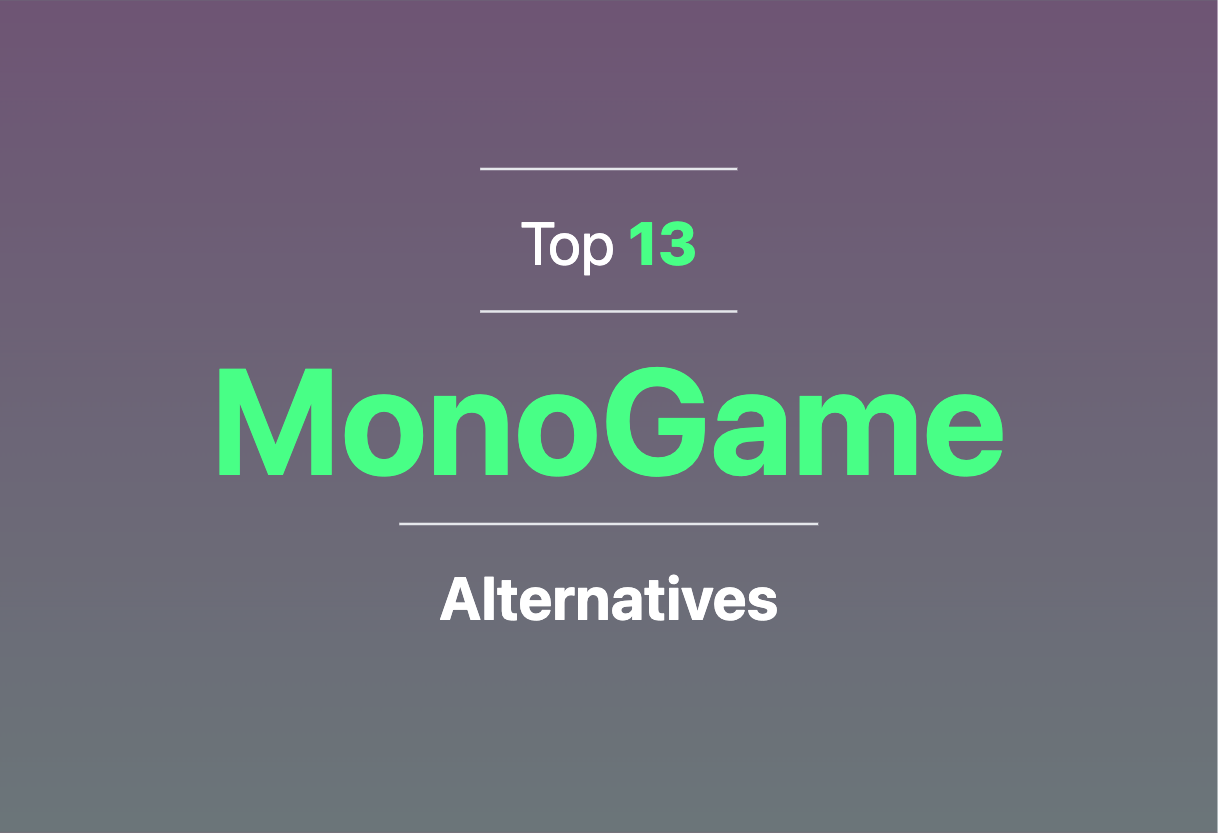
If you’re on the lookout for alternatives to MonoGame, you might consider XNA, Godot, GameMaker, Bevy, Love2D, LibGDX, Raylib, SDL, Pygame, Unity, FNA, Construct 3, Panda3D.
XNA
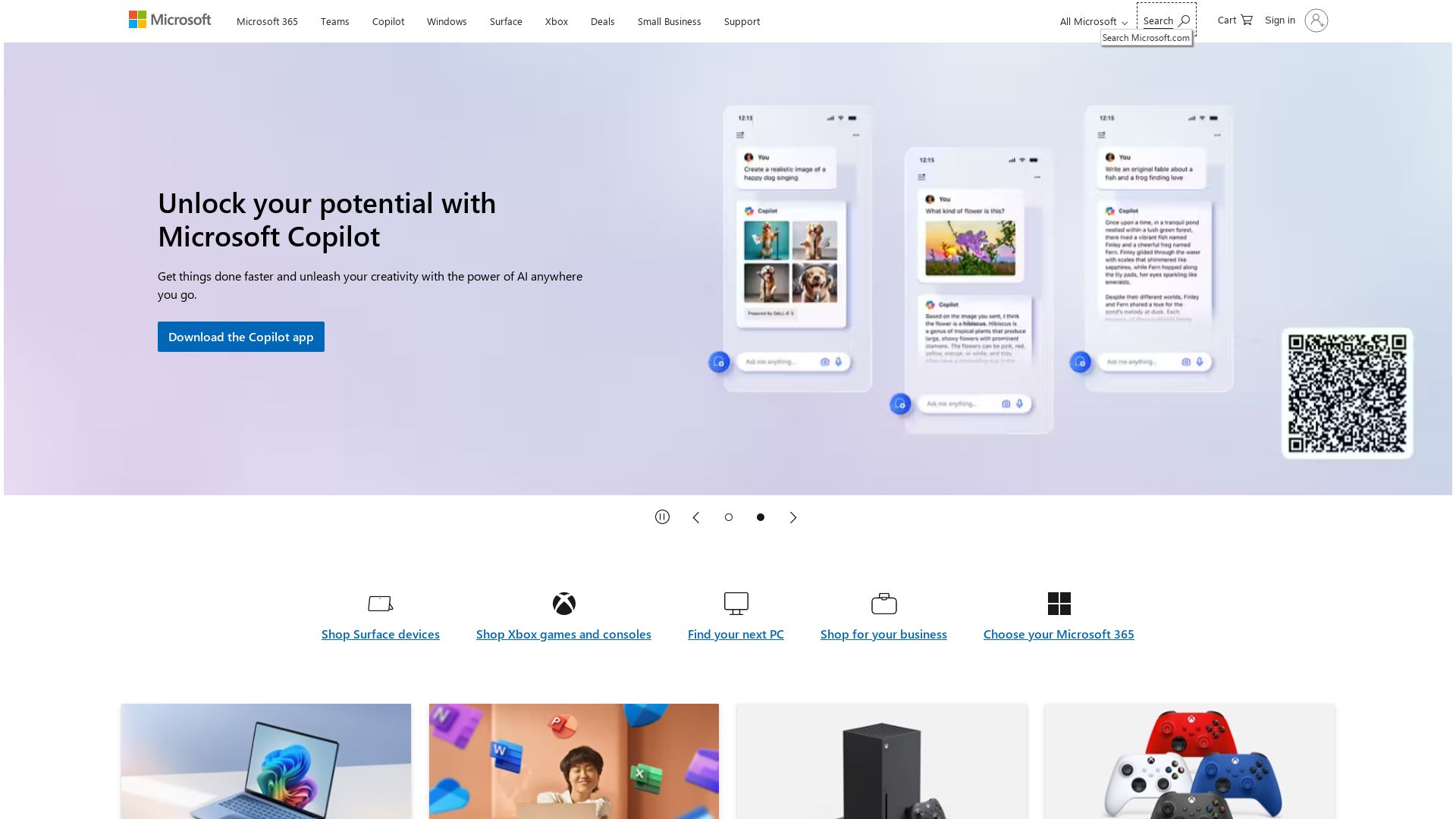
XNA is an innovative game development framework and toolset created by Microsoft. Born on March 24, 2004, it stands at the intersection of the .NET Framework, and is designed mainly for the creation of video games on platforms like Windows and Xbox 360.
XNA Top Features
- Facilitate Game Development: XNA permits developers to create intricate and engaging video games efficiently.
- .NET Based: The entire foundation of XNA is built on the .NET Framework, offering a robust backend for developers.
- Compatible with Windows & Xbox 360: With XNA, games can be developed and successfully run on both Windows and Xbox 360.
- Asset Pipeline Management: XNA provides a good grasp over game asset pipeline management tools, making game development more organized.
| XNA Game Studio | A specialized development environment dedicated to XNA project creation. |
| Built-in State Objects | Implemented features to manage game states and ensure smooth game flow. |
| Vibration Support | XNA gives developers the ability to incorporate Xbox 360 controller vibrations into games. |
XNA Limitations
- As of January 2013, No further development on XNA by Microsoft, extinguishing the prospects of platform evolution.
- Incompatibility with Windows Runtime, restricting the spread of XNA developed games across devices.
- The framework prohibits commercial networking without specific agreements, restricting the use of Xbox Live and Games for Windows Live.
XNA Use Cases
Use case 1
XNA provides a robust foundation for commercial game developers targeting Windows. Notable games developed include Arelite Core, Battle High, and Bloodline Champions.
Use case 2
XNA also serves as a powerful tool for crafting games for Xbox 360. Titles like ApocZ, Biocide, and Charlie Murder owe their creation to XNA Game Studio.
Use case 3
Independently-run competitions such as Microsoft’s Dream Build Play have used XNA to stimulate indie game development, leading to a global surge in autonomous game creation.
Godot
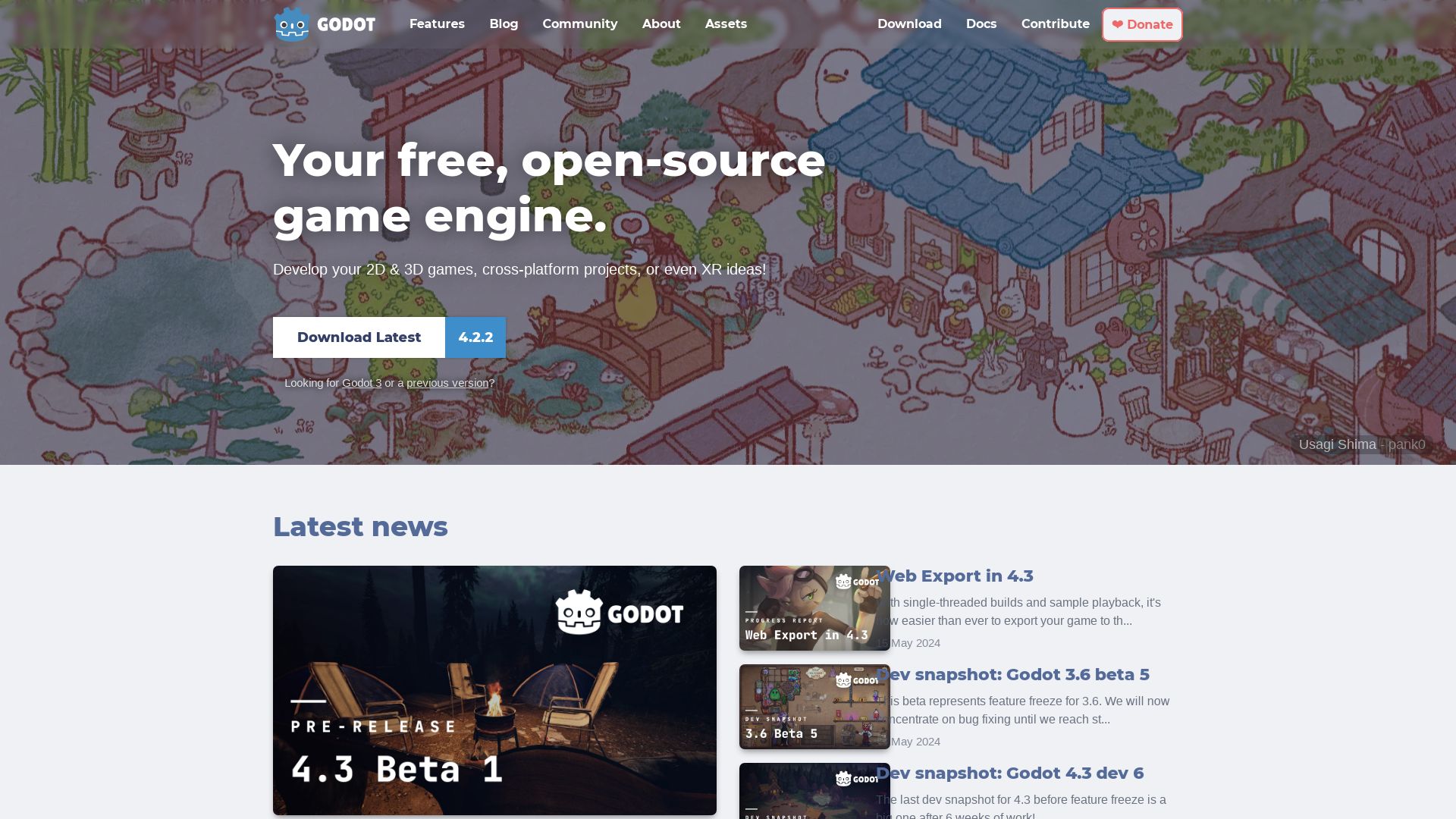
An open-source game engine, Godot provides developers with a scene-driven design approach to game creation. Moreover, it allows game components to be built from the ground up, offering a flexible development environment through its uniquely powerful node system.
Top Features of Godot
- Intuitive scene-driven design: Allows complex scenes to be constructed from simple blocks, aiding in the creation of dynamic, reusable game elements.
- Tight engine integration: Streamlined game logic via GDScript and added support for languages like C#, Rust, Nim and Python.
- 3D engine flexibility: Support for both high and low-end devices, including a specific workflow for 2D game creation.
- Direct Blender import: Seamless incorporation of Blender files into the development process.
| Collaborative storage solution | Designed for team contributions, ideal for large-scale projects. |
| Multi-platform support | Compatible with Windows, macOS, Linux and also extends its support to mobile and web platforms. |
| Free and open-source | Licensed under the MIT license, Godot offers its codebase for modification and improvement. |
Limitations of Godot
- Not suitable for complex 3D game development.
- GDScript, though reminiscent of Python, may require a learning curve for some developers.
- .NET compatibility is limited to desktop platforms in Godot 4.
Godot Pricing
As an open-source game engine, Godot is completely free to use with no licensing fees, contracts, or hidden fees.
Godot Use Cases
Indie Game Development
With its easy-to-understand yet powerful design scheme and free pricing model, Godot serves as an excellent platform for independent game developers.
2D Game Development
Godot’s specialized 2D workflow makes it a strong contender for creating visually appealing and smooth 2D games.
Educational Use
With its intuitive design and collaborative capabilities, Godot can be an efficient learning tool for students in game development courses.
FNA
An effective reimplementation of Microsoft XNA Game Studio 4.0 Refresh libraries, FNA is designed by the accomplished developer Ethan Lee. FNA focuses on open platforms, maintaining the integrity of XNA game library with an accurate representation of XNA features.
FNA Top Features
- Plentiful platform options: Windows, macOS, GNU/Linux, iOS, tvOS, Xbox, Google Stadia, and Nintendo Switch.
- No game-specific hacks: Ensuring a clean, comprehensive code for all games developed.
- Single Assembly File Support: Easily build on any platform functions irrespective of the build location.
- Free Open Source Software: FNA strictly uses FOSS, providing software unrestrained by proprietary restrictions.
| Feature | Description |
|---|---|
| Forked from MonoGame | Formerly known as MonoGame-SDL2, it utilizes SDL2 for game porting. |
| Compatibility with Completed XNA4 Games | Completed XNA4 games can be effectively ported to FNA. |
| Exclusive Library Association | Associated libraries include SDL2#, TheoraPlay#, and MonoKickstart. |
FNA Limitations
- No support for closed platforms and technologies: Only supports open platforms.
- Non-Desktop limitations: While fantastic for desktop platforms, FNA doesn’t target non-desktop platforms.
- Dependence on completed XNA4 games: While it is able to import completed XNA4 games, it cannot be used to develop them.
FNA Pricing
Being a Free Open Source Software (FOSS), the use of FNA is free without any pricing concerns.
FNA Use Cases
Use case 1: Indie Game Developers
FNA offers the flexibility and freedom provided by open source software, making it splendid for Indie Developers, especially those who favor open platforms.
Use case 2: Legacy XNA Game Porting
With its propensity for accurate XNA4 behaviour, FNA proves to be an exceptional choice for developers looking to port their legacy XNA games.
Use case 3: Open Platform Adherents
Those who strictly develop for open platforms will find FNA a perfect match, given its focus on open platforms and non-support for closed systems.
Construct 3

Developed by Scirra Ltd, Construct 3 is an HTML5-based 2D video game engine aimed at beginners and professional developers. Boasting an easy-to-use event sheet system, Construct 3 allows swift creation of games without the need for extensive coding knowledge.
Construct 3 Top Features
- Event sheet system: This logic-based system triggers actions when conditions are met, eliminating the need for heavy coding.
- Device flexibility and offline use: Construct 3 can be used on any device with browser support and offers offline functionality.
- Pixel editor and in-built behaviors: Facilitates game graphics creation and supports features like solid, platformer, tile movement etc.
- JavaScript integration: Introduced in 2019, it offers advanced users more flexibility.
| Feature | Description |
|---|---|
| HTML5 and online storefronts support | More robust than GameMaker in its support for HTML5 and online storefronts, Construct 3 accommodates multiple browsers. |
| Data privacy compliance | Construct 3 is compliant with all major data privacy regulations including COPPA, CCPA, and GDPR. |
| Availability of educational resources | Construct 3 provides starter curriculum, tutorials, manuals, and support for educators. |
Construct 3 Limitations
- Limited scope for large-sized games: While versatile, Construct 3 struggles with the creation of larger games.
- 2D-focused: Construct 3 excels at 2D game creation but isn’t equipped for 3D game development.
- Device-dependent exports: Exporting games for HTML5 and Construct 3 depends on the device’s support for web content.
Construct 3 Pricing
Construct 3 offers a free license version and a paid subscription with additional features starting at $99/year for the personal plan.
Construct 3 Use Cases
Use Case 1 – Indie Developers
With its simplicity and swift game development process, Construct 3 becomes an ideal choice for indie developers.
Use Case 2 – Educators
A favorite in 400 schools across 48 states in the US, Construct 3’s easy programming process is a practical tool in teaching coding and game design.
Use Case 3 – Professional Developers
The optional JavaScript scripting and wide browser compatibility make Construct 3 a dependable platform for professional developers.
Panda3D

Established in 2002, Panda3D is a highly capable open source game engine, utilized by both commercial game developers and educational institutions. Powered by Python and C++, it offers an extensive range of functionalities relevant to 3D game development. Originally devised for Disney’s 3D theme park attractions, it now has grown into a popular choice for developers globally.
Top Features of Panda3D
- Platform Compatibility: Panda3D operates on an array of platforms such as Microsoft Windows, Linux, macOS, and Free BSD.
- Graphics and Audio: It includes dynamic functionalities such as 3D audio, physics system, collision detection, and supports modern per-pixel lighting techniques.
- Scripting: Both Python and C++ are fully supported languages for scripting in Panda3D.
| Feature | Description |
|---|---|
| Accessibility | Open sourced for everyone to use and staffed by an active community for support. |
| Documentation | Extensive guides and instructions are available for reference and ideation. |
| Cross-Compiling | Offers an Android cross-compile option. |
Panda3D Limitations
- Learning Curve: Panda3D isn’t a beginner’s toy. It necessitates a fundamental knowledge of Python and APIs.
- Dependency: It includes numerous third-party libraries such as Nvidia Cg, DirectX, and MFC, which can lead to integration complexities.
Panda3D Pricing
Panda3D is open source and completely free to use. The development and maintenance, however, accept financial support through its OpenCollective campaign.
Panda3D Use Cases
Commercial Game Development
Professional game creators can use Panda3D’s comprehensive features to develop intricate and visually appealing games similar to Toontown Online and Ghost Pirates of Vooju Island.
Educational Use
Universities like Carnegie Mellon’s Entertainment Technology Center utilize Panda3D for Virtual Reality research projects, offering students direct experience with 3D game development.
Open-Sourced Projects
Because of Panda3D’s open-source status, it breeds a vast ecosystem of global developers sharing, modifying, and collaborating on projects to achieve new possibilities in gaming.
GameMaker
Hailed as a paradigm for 2D game engines, GameMaker elegantly marries simplicity and scalability. Revered by both beginners and seasoned developers, it opens a world where raw concepts transform into beloved games like Undertale and Forager.
GameMaker Top Features
- Impeccable 17-year pedigree originating from 2D animations, yielding indie successes.
- Consistent balance of new features, maintenance, and customer-centric updates for enhanced experience.
- Support for multiple languages such as Shader Languages (GLSL, HLSL, etc), JSON, and XML via its Language Server for Syntax Highlighting and Intellisense.
- Extension with Mod.io to enable user-generated content effortlessly.
| Future Updates | Description |
|---|---|
| AI support | Integration of AI courtesy of their partnership with OpenAI in 2023. |
| New Code Editor | Hosting within a full-screen window, equipping developers with easy access to objects, events, and functions. |
| Markdown support | Facilitates formatting with side-by-side preview. |
GameMaker Limitations
As elegant as it is, GameMaker squarely focuses on 2D game development, limiting its scope. The feature-rich engine might also present a steep learning curve for absolute beginners before they could fully harness its power.
GameMaker Pricing
With varied tiers designed for different needs – Free, Creator, Indie, and Enterprise, GameMaker ensures there is a concentrated solution for every developer. The tiers are geared from solo desktop store game development to studio releases on major consoles.
GameMaker Use Cases
Aspiring Indie Developer
For those embarking on their journey in game development, GameMaker’s user-friendliness and comprehensive toolset provide a solid foundation.
Seasoned Developers
Professionals seeking scalability in their design have consistently praised GameMaker for empowering game releases across multiple export options.
Studio Releases
With the power to fuel studio releases on major consoles, GameMaker has proven a worthy companion for teams planning large scale projects.
Bevy
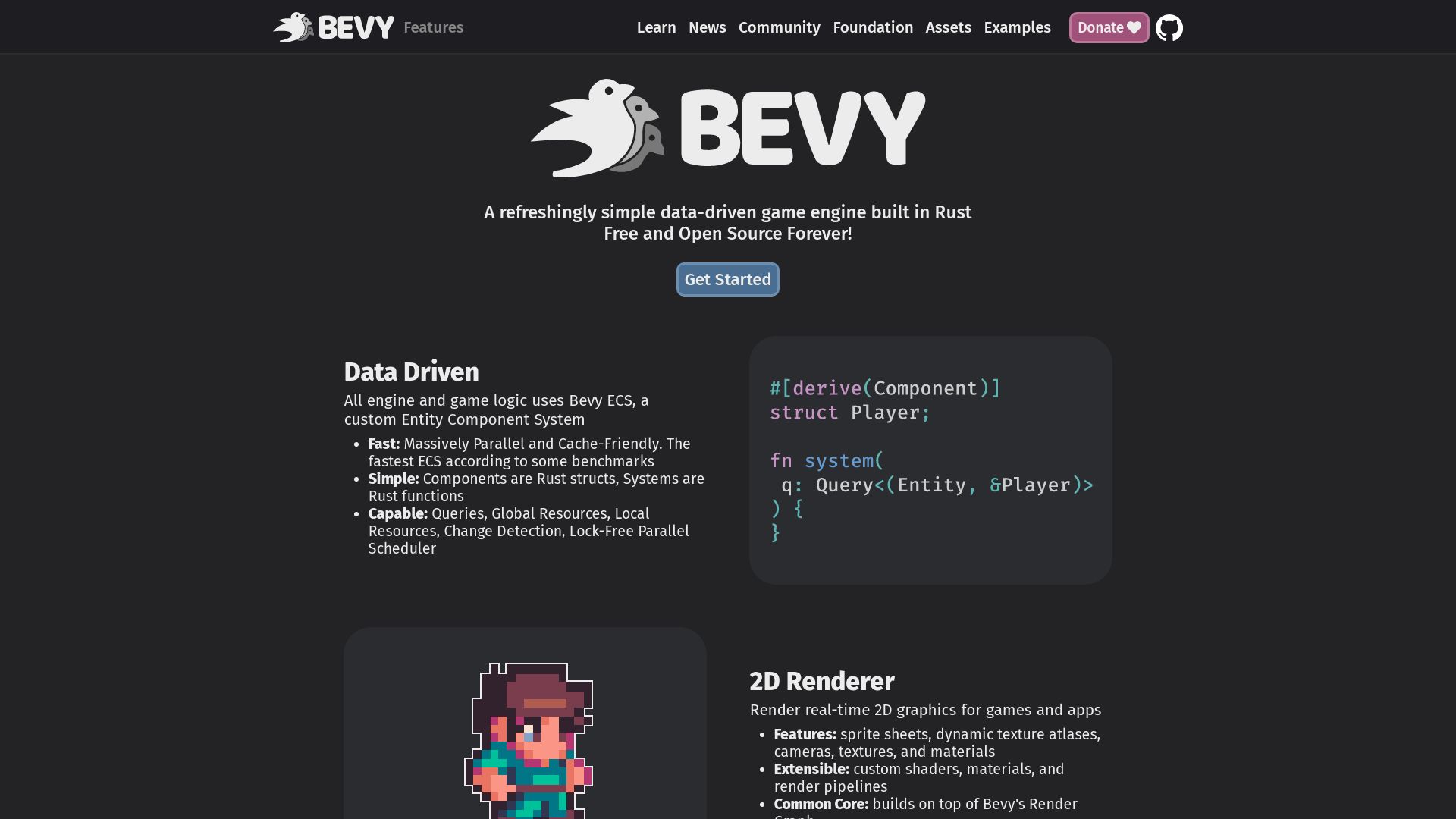
The pulsating heart at the center of your game development needs, Bevy is a data-driven game engine built in Rust. It’s designed around the Entity Component System (ECS) paradigm, lending itself to a data-oriented architecture, with 2D and 3D development capabilities.
Bevy Top Features
- Equipped for 2D and 3D rendering, offering a visually rich and dynamic gaming experience.
- Facilitates user interface functionality, sound loading and hot reloading for feedback in real-time.
- Supports all major platforms, inclusive of Windows, MacOS, Linux, Web, iOS, with Android in the pipeline.
- Fast compile times (0.8-3.0 seconds with the ‘fast compiles’ configuration).
| Additional Features | Includes |
|---|---|
| Open-source and Free | Licensed under MIT or Apache 2.0 |
| Community Support | Discord server, Subreddit, GitHub Discussions and Assets |
| Customizable | Cargo features for personalized functionality |
Bevy Downsides
- Heavy reliance on Rust can lead to API-breaking changes in new versions.
- Despite planning for web standards such as wasm and webgpu, they are currently not included.
Bevy Pricing
Delving into area of Bevy proves cost-effective, as it is free and open-source, licensed under either MIT or Apache 2.0.
Bevy Use Cases
Use case 1 – Indie Games Development
With its lightweight nature, easy usability, quick compile times, and strong community support, Bevy presents a promising choice for indie game developers and enthusiasts.
Use case 2 – Game Education
Bevy’s accessible API and open-source nature can provide an excellent learning resource for those studying and teaching game engine development.
Use case 3 – Game Studios
While the creator primarily sees Bevy catering to indies, its ongoing development and future plans indicate an ambition to appeal to larger studios.
Love2D
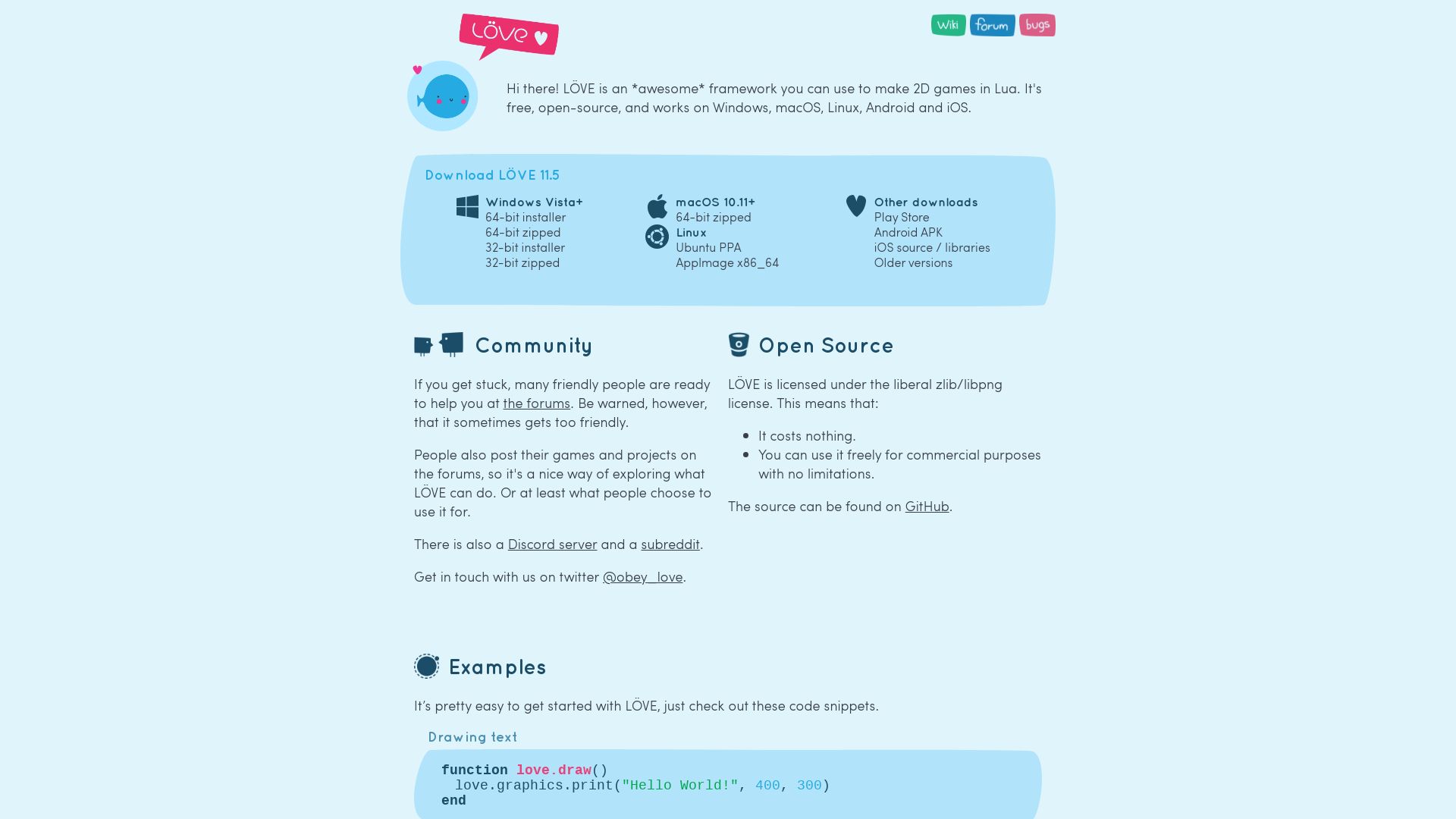
Bathing in the golden aura of its presence since its initial release in January 2008, Love2D stands tall as a free, open-source game framework. Bestowed from the creative minds that breathed life into C++, this platform echoes its expertise across platforms such as Windows, Linux, macOS, iOS, Android, and beyond.
Love2D Top Features
- Robust support for Lua scripting language, freeing the reigns of creativity.
- Ability to access video and sound functions.
- Potent compatibility with libraries SDL and OpenGL.
- A lineage of versions dating back to the transformative piLöve, a Raspberry Pi specific release.
| Feature | Benefit |
|---|---|
| Physics engine Box2D | Enabling real-world game dynamics |
| LuaSocket library | Facilitating network communications |
| Community support | Offering user assistance via Discord, IRC, issue tracker |
Love2D Limitations
- Lacking the power voltage when compared to titans like Unreal, Unity.
- Dappled with limited modules, leaving the canvas a shade too empty.
- Bears the caveat of uncertain compatibility between different LÖVE versions.
Love2D Pricing
In a world where quality often echoes with a price tag, Love2D smashes the norms offering its eccentricities under the banner of a free zlib License. Indeed, creativity knows no boundaries, and definitely no price.
Love2D Use Cases
Use case 1
Embraced by game development competitions like Ludum Dare, Love2D manifests its prowess in a battlefield of creativity.
Use case 2
With the notable games’ hall of fame boasting names like Kingdom Rush and Warlock’s Tower, Love2D’s abilities shine for large-scale game developers.
Use case 3
As an integral part of tools like anim8 library and LIKO-12, Love2D blinks its proficiency flag for game development tool creators.
LibGDX
Enter the realm of cross-platform, feature-rich game development with LibGDX. A Java game development framework, it has been consistently delivering quality for over a decade. Embrace seamless game creation with its unified API targeting a plethora of platforms!
LibGDX Top Features
- Unified API: Aim for global inclusion with compatibility ranging from Windows, Linux, macOS, to Android, iOS and even Web.
- Rendering: Experience vivid visuals via OpenGL ES 2.0/3.0 rendering.
- Code-centric Control: Enjoy fine-grained, total authority over your development process.
- Java Ecosystem: Harness the potency of top-notch Java tools like IDEs, debuggers, Git support and more.
- Immense diversity in Features: Amplify user experience with support for audio streaming, gesture detection, in-app purchases, and a plethora of graphical features.
| Feature | Benefit |
|---|---|
| Extensive Third-party Ecosystem | Enhance your game development with a plethora of third-party tools and software. |
| Full Opensource | Enjoy vast customization potential and a seamless development process. |
| Firebase Integration | Take advantage of the deep analytics and user-friendly database. |
LibGDX Downsides
As of now, we haven’t identified any major limitations or disadvantages of LibGDX based on the company summary provided. However, like any technology, it may have its challenges that vary depending on individual project requirements.
LibGDX Pricing
LibGDX is free to use. Celebrate borderless creativity without the stress of overhead costs.
LibGDX Use Cases
Use Case 1: Indie Developers
LibGDX offers a budget-friendly, feature-packed solution for indie developers looking to create engaging multiplatform games.
Use Case 2: Educational Institutions
LibGDX’s extensive documentation and community support make it an exceptional learning tool for schools teaching game development.
Use Case 3: Professional Agencies
Agencies aiming for mass audience reach can leverage LibGDX’s cross-platform capabilities to deliver interactive experiences to a global audience.
Raylib
Initially released in 2013 by Ramon Santamaria and contributors, raylib is a cross-platform game development library. Written in C99, it offers flexibility and power for game developers, making it a worthy alternative to MonoGame.
Raylib Best Features
- Hardware-accelerated with OpenGL with a unique OpenGL abstraction layer: rlgl.
- Fully cross-platform, supporting multiple operating systems including Windows, Linux, macOS, FreeBSD, Android, Raspberry Pi, and HTML5.
- Powerful Fonts module with support for SpriteFonts, BMfonts, TTF, and SDF.
- Full 3D support for models, shapes, billboards, and heightmaps, complemented with a flexible materials system.
- Extensive shaders support including Model shaders and Postprocessing shaders.
- Audio loading and playing capabilities, with streaming support for several formats.
- VR stereo rendering support with configurable HMD device parameters.
| Feature | Description |
|---|---|
| Bindings | Raylib provides bindings for over 50 programming languages, making it highly versatile. |
| No External Dependencies | All required libraries are included, promoting smoother workflows. |
| RayMath Module | Provides quadratic and vector mathematical functions to support complex game physics. |
| RayGui Module | Includes an immediate mode GUI for convenient interface design. |
Raylib Limitations
- No explicit support for multiplayer game features.
- Requires familiarity with C language for effective usage.
- Lacks built-in behavior control for game objects as seen in some alternatives.
Raylib Use Cases
Use case 1 – Teaching Video Game Programming
With its powerful yet accessible features, raylib is used globally for teaching video game programming. Its comprehensive modules and cross-platform support provide a robust foundation for students to learn and hone their programming skills.
Use case 2 – Prototyping and Tooling
Raylib’s efficiency and versatility make it suitable for prototyping and tooling. Developers can utilize its plethora of features to create rapid prototypes for testing game mechanics and visuals.
Use case 3 – Development of Graphical Applications
Thanks to raylib’s support for comprehensive 3D capabilities and multiple texture formats, developers can efficiently create visually stunning graphical applications.
SDL
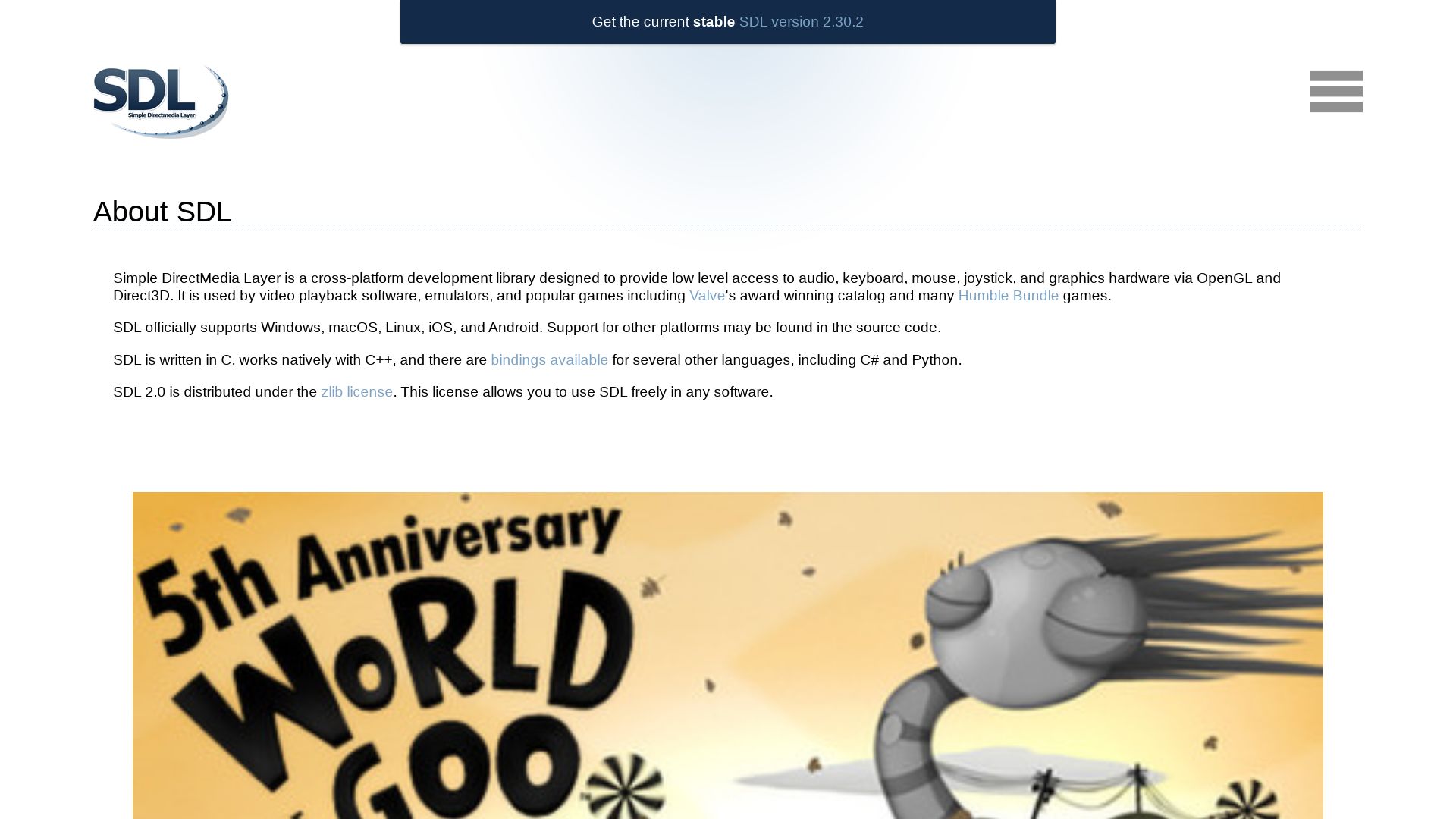
Built by Sam Lantinga in 1998, SDL (Simple DirectMedia Layer) stands as an enduring pillar in the game development world. As a cross-platform development library, SDL provides a harmonized interface to multimedia hardware components, focusing on allowing developers to create intricate video games.
SDL Top Features
- Language Compatibility: Primarily leveraging C and C++, SDL provides its API in C with further support for other languages.
- Cross-Platform Development: Compatibility with platforms such as Android, iOS, Linux, macOS, and Windows enables expansive software creation.
- Comprehensive Hardware Support: SDL coordinates with video, audio, input devices, CD-ROM, threads, shared object loading, and timers.
- 3D Graphics: SDL can handle OpenGL, Vulkan, Metal, Direct3D11 and other 3D graphic contexts enhancing game realism.
- Extensions: SDL incorporates a myriad of extensions like SML_image, SDL_net, SDL_mixer, SDL_ttf, SDL_rtf for superior capabilities.
- Hardware-accelerated Rendering API: The texture-based rendering API is hardware-accelerated, promoting high-responsive games.
| Structure and Ease of Use | SDL_Game Development guide and SDL tutorials elucidate 2D game creation, integrating functionalities from SDL_image, SDL_ttf, SDL_mixer. The platform is well-documented and cooperative. |
| Sound Mixing | With files like SDL_haptic.h, SDL_audio.h, SDL excels in complex audio functions offering immersive audio experiences. |
| Geometry Rendering | SDL supports advanced geometry rendering, color keying, clip rendering and the inclusion of sprite sheets and texture loading. |
SDL Limitations
- Backwards Compatibility: SDL 2.0 broke backwards-compatibility, making it less suited for those seeking a backwards compatible API.
- Windows SDK: Building with SDL on Windows requires the latest DirectX SDK which could add an overhead.
SDL Pricing
SDL remains a free and open-source library, inviting developers of varying backgrounds to utilize its tools.
SDL Use Cases
Use case 1: Cross-Platform 2D Games
Given its flexibility and wide support for multiple platforms, SDL proves to be an efficient choice for developing 2D gamed with reusable frameworks on Android/iOS using the latest SDL 2.0 and C++ frameworks.
Use case 2: Large-Scale Projects
SDL’s support for an array of hardware components, advanced timers, and optimized surface loading, all contribute to its viability for large, complex game projects.
Use case 3: Multimedia Applications
Aside from games, SDL’s extensive support for multiple media types and object-oriented programming makes it beneficial for creating robust multimedia applications.
Pygame

Embarking on a game development journey? Consider Pygame, a set of Python modules packed with features for creating immersive video games. It’s a tool authored by seasoned developers, Lenard Lindstrom, René Dudfield, Pete Shinners and others. Having demonstrated a constant evolution since its inception in October 2000, it currently operates under-version 2.5.0, with a diverse codebase leveraging Python, C, Cython, and Assembly.
Pygame Top Features
- Cross-platform capabilities: highly portable, Pygame runs on nearly all operating systems, handheld devices, and game consoles, even OLPC computers.
- SDL library utilization: Simplifies real-time game development and caters for aspects like pixel-array manipulation and transformations, vector math, collision detection, 2D sprite scene graph management and MIDI support.
- Android compatibility: Through Pygame Subset for Android (pgs4a), it enables support holding for sound, vibration, keyboard and accelerometer.
- Community-based: User-friendly platform with a community-driven development approach and numerous tutorials for new cloud users.
| Feature | Description |
|---|---|
| Background scrolling | Control your game visuals by adjusting the background scrolling speed. |
| Increased FPS | Obtain control over your game’s speed by increasing or decreasing FPS. |
| Code speed | Pygame code runs 10-20 times faster than Python, and Assembly Language is 100x faster than Python code, for a smooth game experience. |
Pygame Downsides
- Limited to Python and related languages, which may not accommodate developers fluent in other languages.
- For large scale complex games, performance, and graphics capabilities may trail behind more robust gaming engines.
Pygame Pricing
Pygame relieves financial constraints. It’s an open-source, free-to-use platform. You’re free to develop open source, freeware, shareware, and commercial games.
Pygame Use Cases
Use case 1: Beginner Programmers
Pygame is a top choice for beginners, young kids, college students and first-time programmers due to its relative simplicity and ease of understanding.
Use case 2: Mobile Game Developers
Android compatibility makes Pygame an ideal tool for developers targeting mobile devices.
Use case 3: Educational Institutions
With open-source licensing, educational institutions can utilize Pygame for teaching without incurring additional costs.
Unity

Launched in 2005, Unity is a flexible game development engine dominating in creating immersive 3D and 2D games. Its robust compatibility extends across Android, iOS, and several operating systems.
Unity’s Dominating Features
- State-of-the-art rendering technology and feature-rich tool suite.
- Indispensable for crafting diversified applications, from Augmented Reality to complex 3D simulations.
- Integrated with a rich asset store featuring pre-designed textures and features, sparking ingenuity in game designs.
- Expansive compatibility with coding languages including BOO script, JavaScript, and C#.
- Promotes constant learning and open communication via an active developer community.
| Version | Features |
|---|---|
| Free Version | Provides substantial features to facilitate the production of high-quality games |
| Pro Version | Offers additional advanced features for deeper manipulation and finer tuning |
Unity Drawbacks
- Anticipated pricing shift by January 1, 2024, causing unease among developers.
- Retroactive fees could clash with the financial stability of developers, particularly indie, solo, and mobile developers.
- Per-install fees potentially prone to abuse; fear of repeated downloads by a single user.
Unity Pricing
The new pricing model sets an install fee per game using Unity software. Developers will not be charged until their game surpasses $200,000 in revenue and 200,000 installations. Note: Fees vary for standard and emerging markets.
Unity Use Cases
Use case 1: Mobile Game Development
Unity’s cross-platform launch capability empowers developers to create dynamic mobile games spanning Android and iOS.
Use case 2: AR/VR Features
Unity provides developers with the tools needed to push the envelope in the design and creation of games with immersive AR/VR features.
Use case 3: Community Collaboration
The engine’s active developer community expedites problem-solving and fosters an environment of learning and collaborative improvement.
Logan Bellbrook
Content writer @ Aircada with a knack for nature & AR/VR/XR. Blogging the intersection of tech & terrain.



